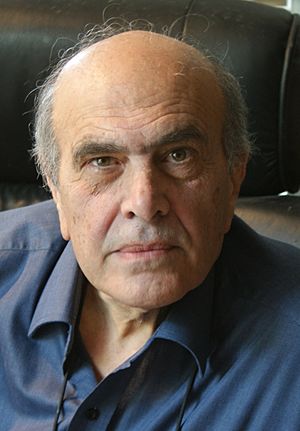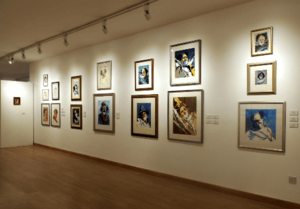Muhanna Al-Dura facts for kids
Quick facts for kids
Mohanna Durra
|
|
|---|---|
 |
|
| Born | 1938 |
| Died | 24 January 2021 (aged 82–83) |
| Nationality | Jordanian |
| Education | George Aleef, Jordan; Academy of Fine Arts, Rome (1958) |
| Known for | Pioneer of Jordanian art movement, introduced cubism to Jordanian art community |
| Movement | Orientalist themes; Cubism; abstract art |
| Awards | Al-Hussein Decoration |
Mohanna Durra (Arabic: مهنا دره) (1938 – 24 January 2021) was a famous Jordanian painter. He is known as a pioneer of the Jordanian art movement. He was the first artist to bring Cubism and abstract art to Jordan. Mohanna Durra was also a professor at the University of Jordan and led the Jordan Association of Fine Arts.
Contents
Early Life in Amman
Mohanna Durra was born in Amman, Jordan in 1938. His father was from Lebanon and his mother was Turkish. He grew up in a red house on a hilltop in downtown Amman. This house was near the famous Roman amphitheater. People believed the house was on top of an old Roman cemetery. As a child, stories about ghosts and spirits in his neighborhood made him curious about things beyond the real world.
Learning and Career
Mohanna Durra was a rebellious young person who loved to draw. His father sent him to study art with George Allief. Allief was a former Russian officer. He taught Mohanna the basics of watercolor, drawing, and painting. He also taught him about perspective, which is how to make things look like they are far away or close up. These lessons helped Mohanna become a professional artist.
Durra once drew a portrait of his first teacher, George Allief. When Durra returned from Rome, Allief was worried that Durra's art had become too modern. But after Durra painted him, Allief saw his talent and forgave him for changing his style.
Later, Mohanna met a Dutch painter named William Hallowin. Hallowin showed him the works of Rembrandt and the Dutch art style. This made Durra very interested in how light is used in paintings.
In 1954, Mohanna Durra went to the Academy of Fine Arts in Rome. He was the first Jordanian to get a formal art education there. He felt that the academy was not what he expected. So, he spent his time studying classic art in museums and churches. After finishing his studies in 1958, Durra came back to Amman. He taught art history at the Teachers' Training College. In 1964, he started the Fine Arts Section at the Department of Culture and Art in Amman. Then, in 1970, he created the Jordan Institute of Fine Arts.
Between 1960 and 1970, Durra went back to Rome. There, he tried out different styles like abstract art and Cubism. In 1970, he returned to Jordan and received an award from King Hussein. Around that time, Durra opened his own art studio. He was the first Jordanian to open a studio to teach local students. Two of his famous students were Princess Wijdan Ali, who helped bring back Islamic art traditions, and Nawal Abdallah, a leading artist in Jordan today.
Mohanna Durra's Art
Durra was well-known for his portraits. He was also famous for how he used colors in his paintings. He was the first artist to introduce Cubism and abstract art to the Jordanian art community. Mohanna Durra was a Jordanian artist at heart. In his early years, he often painted Bedouin people and local Jordanian scenes.
Famous Paintings
- Blue Man Árabe, 1966
- Cubista Paisaje Urbano, 1966
- Portrait of Two Women, 1975
- Composition No. 3, oil on canvas, 75 X 95 cm, 1977
- Autumn Dew, 1981
- Old Salti Woman, 1964
Awards and Recognition
Mohanna Durra also worked as a diplomat for Jordan. He served in Italy, Tunisia, Egypt, and later in Russia as an Ambassador.
In 2002, the Jordanian Postal Authorities released a postage stamp to honor Mohanna Durra. The stamp showed one of his paintings. In 2006, the Ministry of Culture named an art gallery after him. They also held a special event about his art with other Jordanian artists.
Key Awards
- 1965 Knight of the Holy Order of St. Sylvester (from Pope Paul VI)
- 1970 Order of the Star of Jordan (from King Hussein)
- 1977 State Appreciation Award for his cultural work in Jordan
- 1978 Golden Medal from the Italian Ministry of Cultural Heritage
- 1980 Golden Pioneer Medal from the Union of Arab Artists
- 1992 Elected member of the International Informatization Academy
- 2006 Order of the Star of Italian Solidarity
- 2008 Distinction of Al-Hussein Decoration (First Order) from King Abdullah II of Jordan
Exhibitions and Collections
Durra had many solo art shows in cities like Rome, Florence, and Moscow. He also exhibited in various Arab and European capitals, Washington D.C., and at the Venice Biennale Exhibition in 1988. Later, he had shows in Saint Petersburg, the Jordan National Gallery of Fine Arts, and Vienna. In 2000, an exhibition called "Muhanna Forever: Pioneer of Modern Art in Jordan" was held at the Jordan National Gallery of Fine Arts. In 2006, he had a solo show at Lines Gallery in Amman.
Mohanna Durra's artwork is part of many important collections around the world. These include collections at the Vatican, the Imperial Court of Japan, and the Jordan National Gallery of Fine Arts. His work is also in universities like the University of San Francisco and Georgetown University.
See also
- George Aleef
- Islamic art
- Jordanian art
- Jordan National Gallery of Fine Arts
- List of Jordanians


